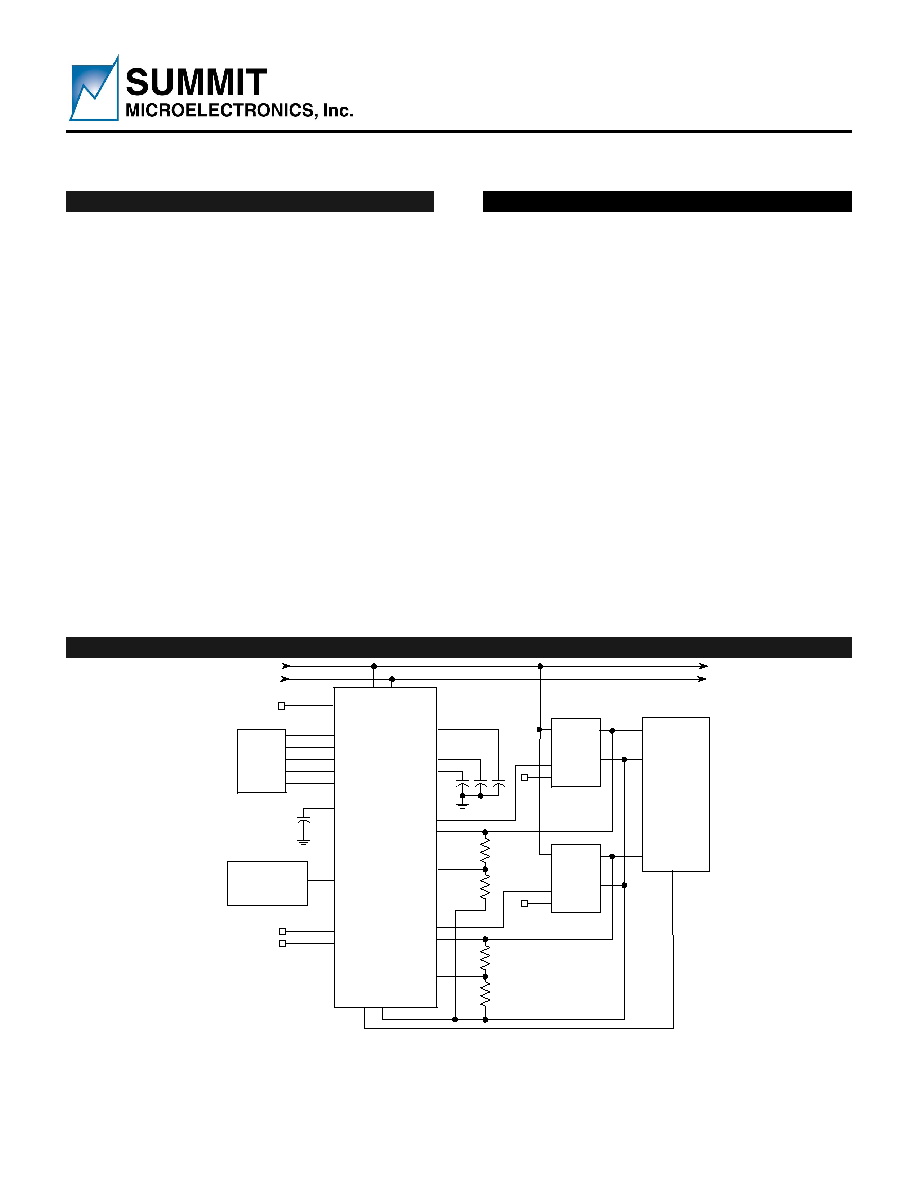
SMM205
Preliminary Information
1
(See Last Page)
© SUMMIT Microelectronics, Inc. 2003 ∑
1717 Fox Drive ∑ San Jose CA 95131 ∑ Phone 408 436-9890 ∑ FAX 408 436-9897
www.summitmicro.com
2069 1.4 6/23/03
1
FEATURES & APPLICATIONS
∑ Extremely accurate (±0.1%) Active
DC Output Control (ADOC)
∑ ADOC Automatically adjusts supply output
voltage level under all load conditions
∑ Capable of margining supplies with trim inputs
using either positive or negative trim pin control
∑ Wide Margin/ADOC range from 0.3V to VDD
∑ Uses either an internal or external VREF
∑ Operates from any intermediate bus supply
from 8V to 15V and from 2.7V to 5.5V
∑ Programmable START and READY pins
∑ Two programmable general purpose monitor
sensors ≠ UV and OV with FAULT Output Flag
∑ General Purpose 1k EEPROM with Write Protect
∑ I
2
C 2-wire serial bus for programming
configuration and monitoring status.
∑ 28 lead QFN package
Applications
∑ In-system test and control of Point-of-Load
(POL) Power Supplies for Multi-voltage
Processors, DSPs and ASICs
∑ Enterprise and edge routers, servers, Storage
Area Networks
INTRODUCTION
The SMM205 actively controls the output voltage level
of two DC/DC converters that use a Trim or VADJ/FB
pin to adjust the output. An Active DC Output Control
(ADOC) feature is used during normal operation to
maintain extremely accurate settings of supply
voltages and, during system test, to control margining
of the supplies using I
2
C commands. Total accuracy
with a ±0.1% external reference is ±0.2%, and ±0.5%
using the internal reference. The device can margin
supplies with either positive or negative trim pin control
within a range of 0.3V to VDD. The SMM105 supply
can be from 12V, 8V, 5V or 3.3V to as low as 2.7V to
accommodate any intermediate bus supply.
The voltage settings (margin high/low and nominal)
are programmed into nonvolatile memory through the
industry standard I
2
C 2-wire data bus. The I
2
C bus is
also used to enable margin high, margin low, ADOC or
normal operation. When margining, the SMM205
checks the voltage output of the converter and make
adjustments to the trim pin via a feedback loop to bring
the voltage to the margin setting. A margining status
register is set to indicate that the system is ready for
test. The SMM205 ADOC continues to monitor and
adjust the channel output at the specified level.
SIMPLIFIED APPLICATIONS DRAWING
START
WP#
VREF_CNTL
TRIM_CAPA
COMP1
TRIMA
COMP2
READY
FA
ULT
#
TRIM_CAPB
TRIMB
VMB
VMA
VD
D
VDD_CAP
12
V
I
N
GND
FILT_CAP
SMM205
6V to 15V
2.7V to 5.5V
Intermediate
Bus Voltage
(IBA
I
2
C
BUS
A0
A2
SCL
SDA
A1
DC/DC
V≠
Trim
V+
Vin
On/Off
DC/DC
V≠
Trim
V+
Vin
On/Off
UV
OV
Processor
V1
V2
GND
External or
Internal
VREF
Figure 1 ≠ Applications Schematic showing the SMM205 ADOC actively control the DC output level of 2
DC/DC Converters as well as provide margin control. The SMM205 can operate over a wide supply range
Note: This is an applications example only. Some pins, components and values are not shown.
Dual Channel Supply Voltage Marginer and Active DC Output Controller
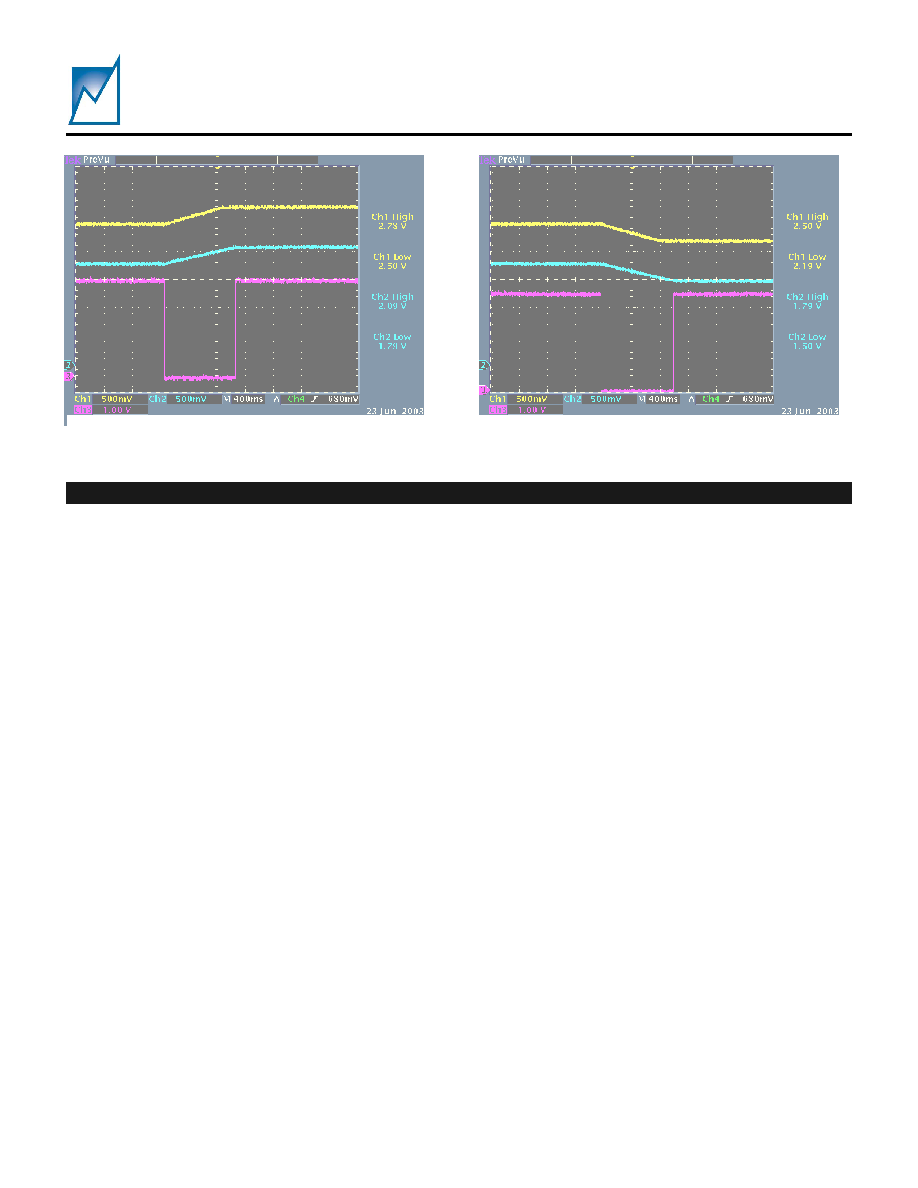
SMM205
Preliminary Information
Summit Microelectronics, Inc
2069 1.4 6/23/03
2
GENERAL DESCRIPTION
The SMM205 is capable of controlling and margining
the DC output voltage of LDOs or DC/DC converters
that use a trim/adjust pin and to automatically change
the level using a unique Active DC Output Control
(ADOC). The ADOC function is programmable over a
standard 2-wire I
2
C serial data interface and can be
used to set the nominal DC output voltage as well as
the margin high and low settings. The part actively
controls the programmed set levels to maintain tight
control over load variations and voltage drops at the
point of load. The margin range will vary depending on
the supply manufacturer and model but the normal
range is 10% adjustment around the nominal output
setting. However, the SMM205 has the capability to
margin from VREF_CNTL to VDD.
The user can set the desired voltage settings
(nominal, margin high and margin low) into the EE
memory array for the device. Then, volatile registers
are used to select one of these settings. The registers
are accessed over the I
2
C bus.
In normal operation, Active DC Output Control is set to
adjust the nominal output voltage of one or two
trimmed converters. Typical converters have
±2%
accuracy ratings for their output voltage. Using the
Active DC Output Control feature of the SMM205 can
increase the accuracy to
±0.2%. This high accuracy
control of a converter output voltage is extremely
important in low voltage applications where deviations
in power supply voltage can result in lower system
performance. Active DC Output Control may be
turned off by de-selecting the function in the Control
Select Register. Active DC Output Control can also be
used for margining a supply during system test.
When the SMM205 receives the command to margin
the Active DC Output Control will adjust the supply to
the selected margin voltage. Once the supply has
reached its margined set point the Ready bit in the
status register will set and the READY pin will go
active. If Active DC Control is disabled a margined
supply can return to its nominal voltage by writing to
the margin command register.
In order to obtain maximum accuracy the SMM205
requires an external voltage reference. An external
reference with ±0.1% accuracy will enable an overall
±0.2% accuracy for the device. A configuration option
also exists so that an internal voltage reference can be
used, but with less accuracy. Total accuracy using the
internal reference is ±0.5%. The SMM205 can be
powered from either a 12V or 8V input via an internal
regulator, or the VDD input (Figure 3).
The SMM205 has two additional input pins and one
additional output pin. The input pins, COMP1 and
COMP2, are high impedance inputs, each connected
to a comparator and compared against the
VREF_CNTL input or the internal reference (VREF).
Each comparator can be independently programmed
to monitor for UV or OV. When either of the COMP1
or COMP2 inputs are in fault the open-drain FAULT#
output will be pulled low. A configuration option exists
to disable the FAULT# output during margining.
Programming of the SMM205 is performed over the
industry standard I
2
C 2-wire serial data interface. A
status register is available to read the state of the part,
and a Write Protect (WP#) pin is available to prevent
writing to the configuration registers and EE memory.
Figure 2 ≠ Example Power Supply Margining using the SMM205. The waveform on the left is margin nominal
to high from 2.5V to 2.8V and 1.8V to 2.1V. The waveform on the right is margin nominal to low from 2.5V to
2.2V and 1.8V to 1.5V. The bottom waveform is the READY signal indicating when margining is complete.

SMM205
Preliminary Information
Summit Microelectronics, Inc
2069 1.4 6/23/03
3
1
9
12
2
28
6
A0
A2
3
START
SCL
SDA
8
WP#
VREF_CNTL
18
19
20
TRIM_CAPA
COMP1
TRIMA
VREF
MUX
COMP2
OUTPUT
CONTROL
11
5
READY
FAULT#
15
16
TRIM_CAPB
TRIMB
TRIM
DRIVE A
TRIM
DRIVE B
INPUT VOLTAGE
SENSING AND
SIGNAL
CONDITIONING
17
14
VMB
VMA
4
A1
I
2
C
INTER-
FACE
SUPPLY
ARBITRATION
3.6V / 5V
REGULATOR
22
23
21
VDD
VDD_CAP
12VIN
EE
CONFIGURATION
REGISTERS
AND MEMORY
7
GND
10 FILT_CAP
CMP
CMP
CMP
Figure 3 ≠Block Diagram.
PACKAGE AND PIN CONFIGURATION
INTERNAL BLOCK DIAGRAM
28 Pin QFN
Top View
1
28
21
20
19
18
17
16
15
22
23
24
25
26
27
2
3
4
5
6
7
14
13
SMM205
Pin 1
SCL
A2
START
A1
READY
A0
GND
WP#
VR
EF_
C
N
T
L
FI
LT_
CAP
FAULT#
NC
COM
P
2
VM
A
VDD
TRIMA
COMP1
TRIM_CAPA
VMB
TRIMB
TRIM_CAPB
SD
A
NC
NC NC NC
V
DD_CAP
12V
I
N
12
11
10
9
8

SMM205
Preliminary Information
Summit Microelectronics, Inc
2069 1.4 6/23/03
4
PIN DESCRIPTIONS
Pin
Number
Pin
Type
Pin Name
Pin Description
28
DATA SDA
I
2
C Bi-directional data line.
1
CLK
SCL
I
2
C clock input.
2
I
A2
4
I
A1
6
I
A0
The address pins are biased either to VDD_CAP or GND. When
communicating with the SMM205 over the 2-wire bus these pins provide a
mechanism for assigning a unique bus address.
8
I
WP#
Write Protect active low input. When asserted writes to the configuration
registers and general purpose EE are not allowed.
10
CAP
FILT_CAP
External capacitor input used to filter the VM inputs.
15, 18
CAP
TRIM_CAPx
External capacitor input used for Active Control and margining.
16, 20
O
TRIMx
Output voltage used to control and/or margin converter voltages. Connect
to the converter trim input.
14, 17
I
VMx
Voltage monitor input. Connect to the DC/DC converter positive sense line
or its +Vout pin.
9
I
VREF_CNTL
Voltage reference input used for DC output control and margining.
VREF_CNTL can be programmed to output the internal 1.25V reference
voltage. Pin should be left open if using VREF internal.
21
PWR VDD
Power supply of the part.
7
GND
GND
Ground of the part. The SMM205 ground pin should be connected to the
ground of the device under control or to a star point ground. PCB layout
should take into consideration ground drops.
22
PWR 12VIN
12V power supply input internally regulated to either 3.6V or 5.5V. When
using the 3.6V internal regulator option the voltage input can be as low as
8V. It can be as high as 15V using the 5.5V internal regulator.
3
I
START
Programmable active high/low input. The START input is used solely for
enabling Active Control and/or margining.
5
I/O
READY
Programmable active high/low open drain output indicates that VM is at its
set point. When programmed as an active high output READY can also be
used as an input. When pulled low it will latch the state of the comparator
inputs.
23
CAP
VDD_CAP
External capacitor input used to filter the internal supply rail.
19
I
COMP1
12
I
COMP2
COMP1 and COMP2 are high impedance inputs, each connected internally
to a comparator and compared against the VREF_CNTL input. Each
comparator can be independently programmed to monitor for UV or OV.
The monitor level is set externally with a resistive voltage divider.
11
O
FAULT#
When either of the COMP1 or COMP2 inputs are in fault the open-drain
FAULT# output will be pulled low. A configuration option exists to disable
the FAULT# output while the device is margining.
13, 24-27
NC
NC
No Connect. Leave floating; do not connect anything to the NC pins.

SMM205
Preliminary Information
Summit Microelectronics, Inc
2069 1.4 6/23/03
5
ABSOLUTE MAXIMUM RATINGS
Temperature Under Bias ......................≠55
∞
C to 125
∞
C
Storage Temperature............................≠65
∞
C to 150
∞
C
Terminal Voltage with Respect to GND:
VDD Supply Voltage .........................≠0.3V to 6.0V
12VIN Supply Voltage.....................≠0.3V to 15.0V
All Others ............................... ≠0.3V to V
DD
+ 0.7V
Output Short Circuit Current ............................... 100mA
Lead Solder Temperature (10 secs)...................300
∞
C
Junction Temperature..........................................150∞C
ESD Rating per JEDEC..................................2000V
Latch-Up testing per JEDEC..........................
±
100mA
Note - The device is not guaranteed to function outside its operating
rating. Stresses listed under Absolute Maximum Ratings may cause
permanent damage to the device. These are stress ratings only and
functional operation of the device at these or any other conditions
outside those listed in the operational sections of the specification is
not implied. Exposure to any absolute maximum rating for extended
periods may affect device performance and reliability. Devices are
ESD sensitive. Handling precautions are recommended.
RECOMMENDED OPERATING CONDITIONS
Temperature Range (Industrial) .......... ≠40
∞
C to +85
∞
C
(Commercial)............ ≠5
∞
C to +70
∞
C
VDD Supply Voltage.................................. 2.7V to 5.5V
12VIN Supply Voltage (1)........................ 8.0V to 14.0V
VIN.............................................................GND to VDD
VOUT.......................................................GND to 15.0V
Package Thermal Resistance (
JA
)
28 Lead QFN...........................................80
o
C/W
Moisture Classification Level 1 (MSL 1) per J-STD- 020
Note (1) -- Range depends on internal regulator set to 3.6V or 5.5V,
see 12VIN specification below.
DC OPERATING CHARACTERISTICS
(Over recommended operating conditions, unless otherwise noted. All voltages are relative to GND.)
Symbol Parameter
Notes
Min.
Typ.
Max
Unit
VDD Supply
Voltage
2.7 3.3 5.5 V
Internally regulated to 5.5V
10
15
V
12VIN Supply
Voltage
Internally regulated to 3.6V
6
14
VM
Positive Sense Voltage
VM pin
≠0.3
VDD
V
I
DD
Power Supply Current from
VDD
All TRIM pins and 12VIN floating
3
5
mA
I
12VIN
Power Supply Current from
12VIN
All TRIM pins and VDD floating
3
5
mA
TRIM Sourcing Max Current
1.5
mA
I
TRIM
TRIM output current
through 100
to 1.0V
TRIM Sinking Max Current
1.5
mA
V
ADOC
Margin Control/ADOC
Range
Depends on Trim range of DC-
DC Converter
VREF_CNTL
VDD
V
VDD = 2.7V
0.9xVDD
VDD
V
IH
Input High Voltage
VDD = 5.0V
0.7xVDD
VDD
V
VDD = 2.7V
0.1xVDD
V
IL
Input Low Voltage
VDD = 5.0V
0.3xVDD
V
V
OL
Programmable Open Drain
Output (READY)
ISINK = TBD
0.2
V
OV/UV
Monitor Voltage Range
COMP1 and COMP2 pins
≠0.3
VDD
V
V
HYST
Base DC Hysteresis
COMP1 and COMP2 pins,
V
TH
≠ V
TL
-- Note 1
3 10
mV
Note 1 ≠ The Base DC Hysteresis voltage is measured with a 1.25V external voltage source. The resulting value is determined by subtracting
Threshold Low from Threshold High (V
TH
≠ V
TL
)
while monitoring the FAULT# pin state. Base DC Hysteresis is measured with a 1.25V input. Actual
DC Hysteresis is derived from the equation: (V
IN
/V
REF
)(Base Hysteresis). For example, if V
IN
= 2.5V and V
REF
= 1.25V then Actual DC Hysteresis =
(2.5V/1.25V) (0.003V) = 6mV.

SMM205
Preliminary Information
Summit Microelectronics, Inc
2069 1.4 6/23/03
6
DC OPERATING CHARACTERISTICS (CONTINUED)
(Over recommended operating conditions, unless otherwise noted. All voltages are relative to GND.)
Symbol Parameter
Notes
Min.
Typ.
Max
Unit
VREF
1.25VREF Output
Voltage
R
LOAD
= 2K
to GND
1.24 1.25 1.26 V
V
REF_CNTL
External V
REF
Voltage
Range
0.25
VDD
V
External VREF=1.25V, ±0.1%
-0.2
+0.2
%
ADOC
ACC
ADOC/Margin
Accuracy
ADOC trimmed to internal VREF
-0.5
+0.5
%
AC OPERATING CHARACTERISTICS
(Over recommended operating conditions, unless otherwise noted. All voltages are relative to GND.)
Symbol Parameter
Notes
Min.
Typ.
Max
Unit
t
DC_CONTROl
Active DC Control
sampling period
Update period for Active DC
Control
1.7 ms
T
settling
Settling Time
+ 10% change in voltage with
0.1% ripple
100 ms
Fast Margin, nom to high,
TRIM_CAP=1
µF
20 ms
T
TRIM
Trim
Speed
Slow Margin, nom to high,
TRIM_CAP=1
µF
200 ms

SMM205
Preliminary Information
Summit Microelectronics, Inc
2069 1.4 6/23/03
7
I
2
C 2-WIRE SERIAL INTERFACE AC OPERATING
CHARACTERISTICS ≠ 100/400kHz
Over recommended operating conditions, unless otherwise noted. All voltages are relative to GND. See Figure 4 Timing Diagram.
100kHz 400kHz
Symbol Description
Conditions
Min Typ Max Min Typ Max Units
f
SCL
SCL Clock Frequency
0 100
0 400
KHz
t
LOW
Clock Low Period
4.7 1.3 µs
t
HIGH
Clock
High
Period
4.0 0.6 µs
t
BUF
Bus Free Time
Before New Transmission
-
Note 1/
4.7 1.3 µs
t
SU:STA
Start Condition Setup Time
4.7
0.6
µs
t
HD:STA
Start Condition Hold Time
4.0
0.6
µs
t
SU:STO
Stop Condition Setup Time
4.7
0.6
µs
t
AA
Clock Edge to Data Valid
SCL low to valid
SDA (cycle n)
0.2 3.5 0.2 0.9 µs
t
DH
Data Output Hold Time
SCL low (cycle n+1)
to SDA change
0.2 0.2 µs
t
R
SCL and SDA Rise Time
Note 1/
1000
1000
ns
t
F
SCL and SDA Fall Time
Note 1/
300 300 ns
t
SU:DAT
Data In Setup Time
250
150
ns
t
HD:DAT
Data In Hold Time
0
0
ns
TI
Noise Filter SCL and SDA
Noise suppression
100
100
ns
t
WR
Write
Cycle
Time
5 5 ms
Note: 1/ - Guaranteed by Design.
t
R
t
F
t
HIGH
t
LOW
t
SU:SDA
t
HD:SDA
t
SU:DAT
t
HD:DAT
t
SU:STO
t
BUF
t
DH
t
AA
SCL
SDA
(IN)
SDA
(OUT)
t
W R (For W rite Operation Only)
Figure 4 . Basic I
2
C Serial Interface Timing
TIMING DIAGRAMS

SMM205
Preliminary Information
Summit Microelectronics, Inc
2069 1.4 6/23/03
8
APPLICATIONS INFORMATION
DEVICE OPERATION
POWER SUPPLY
The SMM205 can be powered by either an 8V to 15V
input through the 12VIN pin or by a 2.7V to 5.5V input
through the VDD pin. The 12VIN pin feeds an internal
programmable regulator that internally generates
either 5.5V or 3.6V. The internal regulator must be set
to 3.6V if using an 8V supply. A voltage arbitration
circuit allows the device to be powered by the highest
voltage from either the regulator output or the VDD
input. This voltage arbitration circuit continuously
checks for these voltages to determine which will
power the SMM205. The resultant internal power
supply rail is connected to the VDD_CAP pin that
allows both filtering and hold-up of the internal power
supply.
VOLTAGE REFERENCE
The SMM205 can operate using either an internal or
external voltage reference, VREF. The internal VREF
is set to 1.25V. Total accuracy with a ±0.1% external
reference is ±0.2%, and ±0.5% using the internal
reference.
MODES OF OPERATION
The SMM205 has one key feature: Active DC Output
Control (ADOC), and two basic modes of operation:
UV/OV monitoring mode and supply margining mode.
A detailed description of each feature and mode
follows.
ACTIVE DC OUTPUT CONTROL (ADOC)
The SMM205 can control the DC output voltage of
bricks or DC/DC converters that have a trim pin. The
TRIM pin on the SMM205 is connected to the trim
input pin on the power supply converter. A sense line
from the channel's point-of-load connects to the VM
input. The Active DC Control function cycles every
1.7ms making slight adjustments to the voltage on the
TRIM output pin based on the voltage input on the VM
pin. This voltage adjustment allows the SMM205 to
control the output voltage of the power supply
converter to within ±0.2% when using a ±0.1%
external voltage reference.
The voltage on the TRIM_CAP pins is buffered and
applied to the TRIM pin. The voltage adjustments on
the TRIM pin cause a slight ripple of less than 1mV on
the power supply voltage. The amplitude of this ripple
is a function of the TRIM_CAP capacitor and the trim
gain of the converter. Calculation of the TRIM_CAP
capacitor to achieve a desired minimum ripple is
detailed in Application Note 37.
The device can be programmed to either enable or
disable the Active DC Control function. When
disabled or not active the TRIM pin on the SMM205 is
a high impedance input. The voltage on the TRIM pin
is buffered and applied to the TRIM_CAP pin charging
the capacitor. This allows a smooth transition from the
converter's nominal voltage to the SMM205 controlling
that voltage to the Active DC Control nominal setting.
There is a programmable Speed-Up Convergence
option. As the name implies, this option decreases the
time required to bring a supply voltage from the
converter's nominal output voltage to the Active DC
Output Control nominal voltage setting.
MONITORING
The SMM205 monitors the COMP1 and COMP2
inputs as well as the VM pins. COMP1 and COMP2
are high impedance inputs, each connected internally
to a comparator and compared against the
VREF_CNTL input. Each comparator can be
independently programmed to monitor for either UV or
OV. The monitor level is set externally with a resistive
voltage divider. The part can be programmed to
trigger the FAULT# pin when either COMPx
comparator has exceeded the UV or OV range. The
READY and FAULT# outputs of the SMM205 are
active as long as the triggering limit remains in a fault
condition. The READY pin is programmable active
high/low open drain output indicates that VM is at its
set point. When programmed as an active high output
READY can also be used as an input. When pulled
low it will latch the state of the comparator inputs.
When either of the COMP1 or COMP2 inputs are in
fault the open-drain FAULT# output will be pulled low.
A configuration option exists to disable the FAULT#
output while the device is in margining mode.
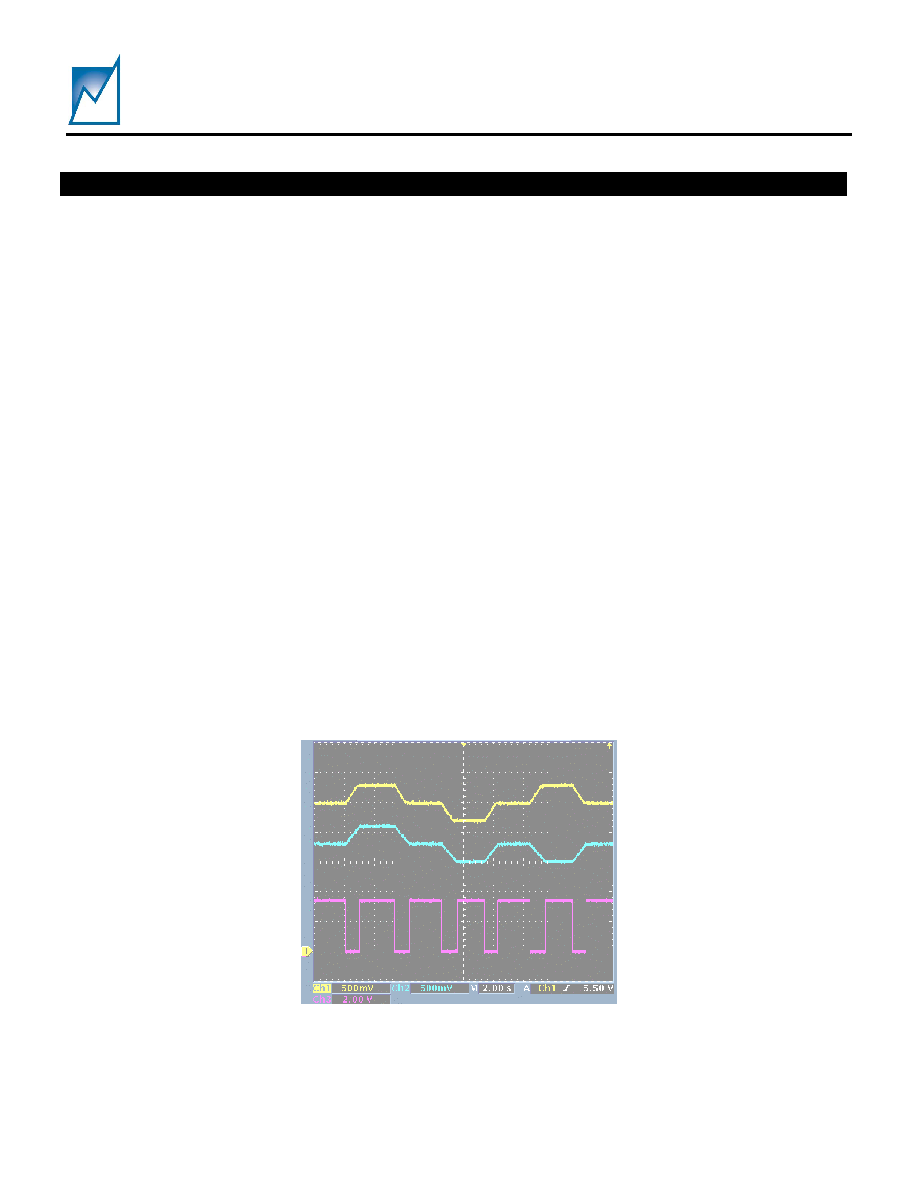
SMM205
Preliminary Information
Summit Microelectronics, Inc
2069 1.4 6/23/03
9
STATUS REGISTER
A status register exists for I
2
C polling of the status of
the COMP1 and COMP2 inputs. Two bits in this
status register reflect the current state of the inputs (1
= fault, 0 = no fault). Two additional bits show the
state of the inputs latched by one of two events
programmed in the configuration. The first event
option is the FAULT# output going active. The second
event option is the READY pin going low. The READY
pin is an I/O. As an output the READY output pin
goes active when the DC controlled voltages are at
their set point. As an input programmed to active high
it can be pulled low externally and latch the state of
the COMP inputs. This second event option allows
the state of the COMP inputs on multiple devices to be
latched at the same time while a host monitors their
FAULT# outputs.
MARGINING
The SMM205 has two additional Active DC Output
Control voltage settings: margin high and margin low.
The margin high and margin low settings can be as
much as
±10% of the nominal setting depending on
the manufacturer. The SMM205 range can be as
large as VREF_CNTL to VDD. These settings are
stored in the configuration registers and are loaded
into the Active DC Output Control voltage setting by
margin commands issued via the I
2
C bus. The device
must be enabled for Active DC Output Control in order
to enable margining.
The margin command registers contain two bits that
decode the commands to margin high, to margin low,
or to control to the nominal setting. Once the SMM205
receives the command to margin the supply voltage it
begins adjusting the supply voltage to move toward
the desired setting. When this voltage setting is
reached a bit is set in the margin status registers and
the READY signal becomes active.
Note: Configuration writes or reads of registers 00
HEX
to 03
HEX
should not be performed while the SMM205 is
margining.
WRITE PROTECTION
Write protection for the SMM205 is located in a volatile
register where the power-on state is defaulted to write
protect. There are separate write protect modes for
the configuration registers and memory. In order to
remove write protection the code 55
HEX
is written to the
write protection register. Other codes will also enable
write protection. For example, writing 59
HEX
will allow
writes to the configuration register but not to the
memory, while writing 35
HEX
will allow writes to the
memory but not to the configuration registers. The
SMM205 also features a Write Protect pin (WP#)
which, when asserted, prevents writing to the
configuration registers and EE memory. In addition to
these two forms of write protection there is also a
configuration register lock bit which, once
programmed, does not allow the configuration
registers to be changed.
Figure 5 ≠ SMM205 margin example. The nominal setting for channel 1 and 2 is 2.5V and 1.8V. The device
margins the DC/DC converters from nominal to high (2.8V and 2.1) then to nominal, then to low (2.3V and
1.5V), then to nominal, then to channel 1 high and channel 2 low, and then back to nominal. The READY
signals goes low when margining and high when complete.
APPLICATIONS INFORMATION (CONTINUED)
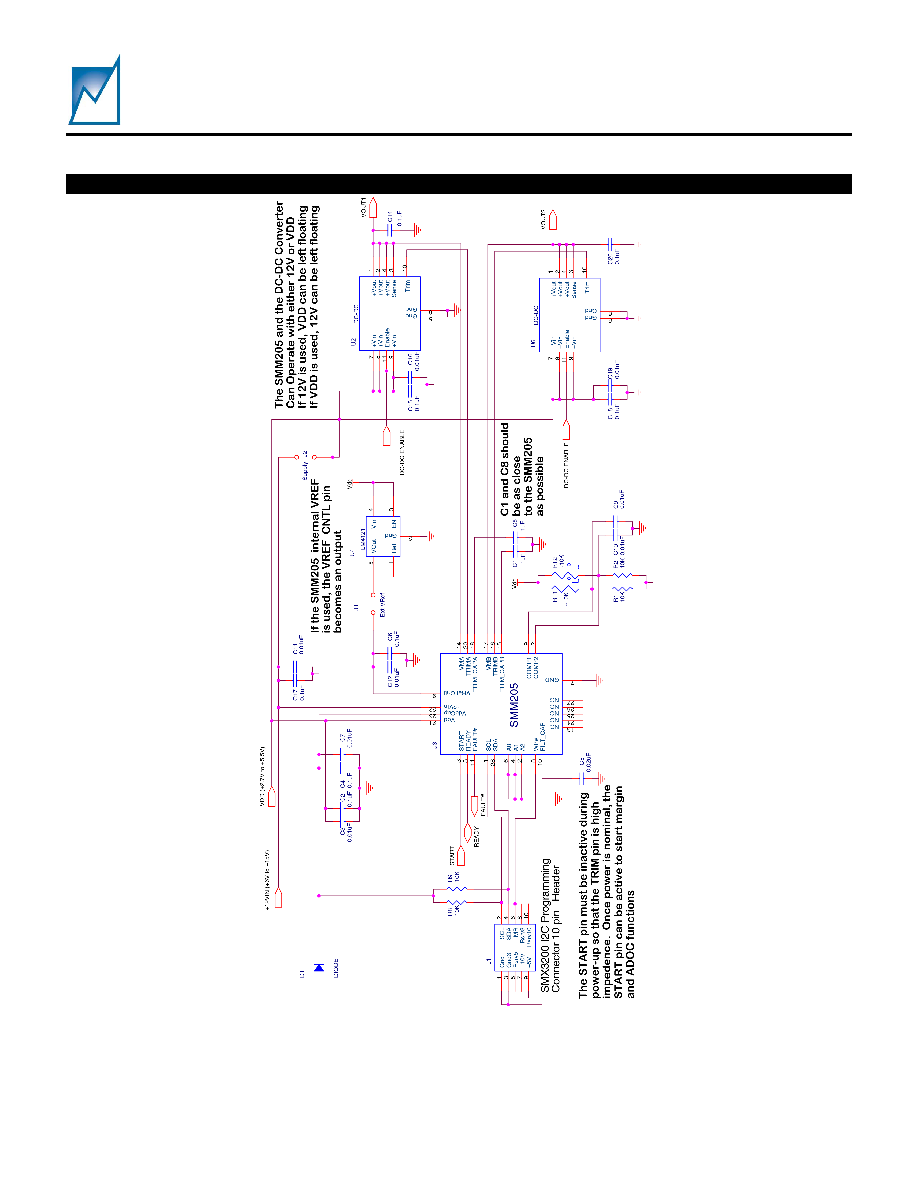
SMM205
Preliminary Information
Summit Microelectronics, Inc
2069 1.4 6/23/03
10
Figure 6 ≠ SMM205 Applications schematic. The accuracy of the external (U4) or internal reference sets the
accuracy of the ADOC function. Total accuracy with a ±0.1% external reference is ±0.2% and ±0.5% with the
internal reference. The 12V supply can go as low as 8V if the internal regulator is set to 3.6V.
APPLICATIONS INFORMATION (CONTINUED)
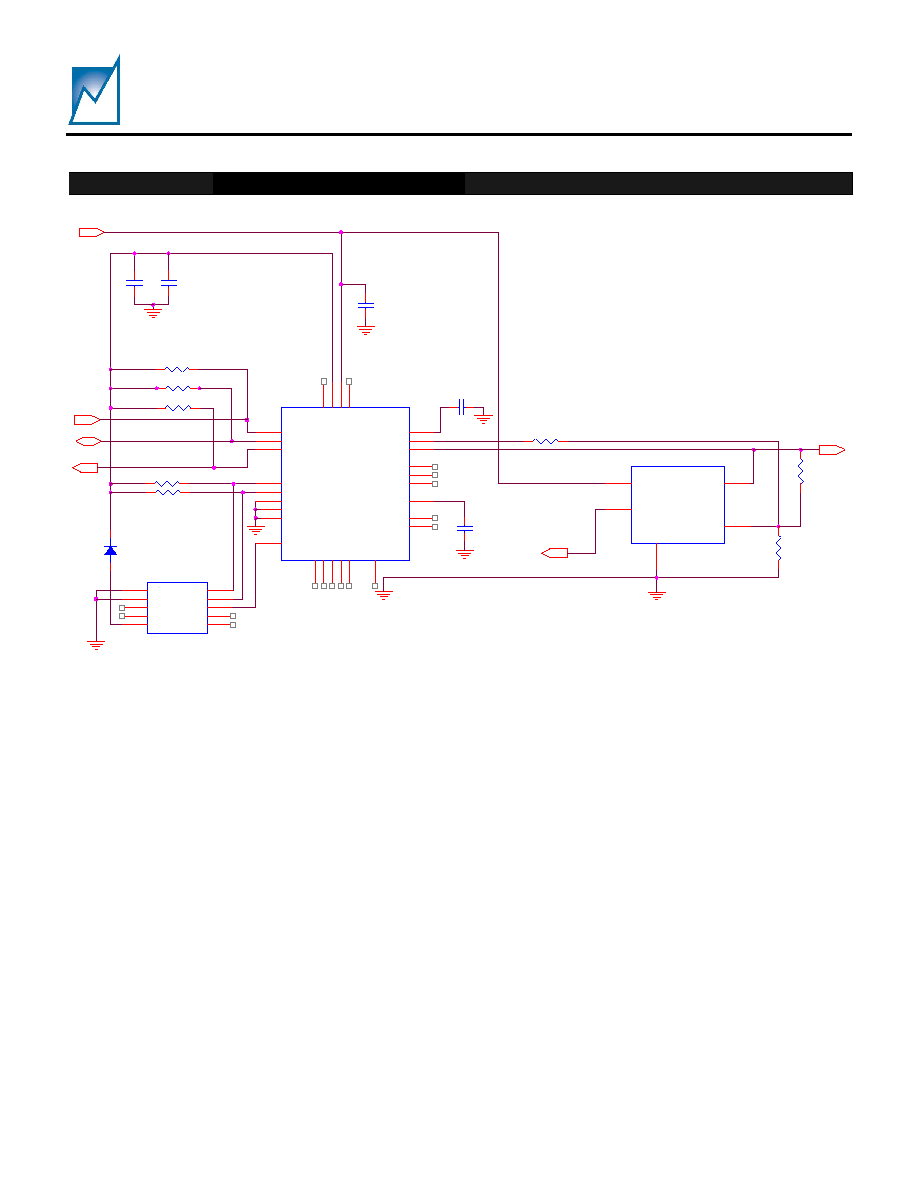
SMM205
Preliminary Information
Summit Microelectronics, Inc
2069 1.4 6/23/03
11
For Example:
If Vout=3.3V, R4=63.4K, 15% of Vout=0.5V
ITRIM=8uA, RTRIM=62.5K
Therefore Rtrim standard 1% value down
from 62.5K
C8
0.1uF
U3
SMM205
1
2
3
4
5
6
7
8
9
10
11
12
13
14
15
16
17
18
19
20
21
22
23
24 25 26 27
28
SCL
A2
START
A1
READY
A0
GND
WP#
VRef Cntl
FILT_CAP
FAULT#
COMP2
NC
VMA
TRIM_CAPB
TRIMB
VMB
TRIM_CAPA
COMP1
TRIMA
Vd
d
12V
In
V
ddCap
NC NC NC NC
SDA
+12VIN (+10V to +15V)
START
R6 10K
C5
0.02uF
J1
1
2
3
4
5
6
7
8
9
10
Gnd
SCL
Gnd3
SDA
Rsrv5
MR
+10V
Rsrv8
+5V
Rsrv10
D1
DIODE
FAULT#
C4
0.1uF
R2 10K
START
R7 10K
READY
The SMM205 START pin must be inactive during power-up so
that the TRIM pin is high impedence. Once power is nominal,
the START pin can be active to start margin and ADOC
functions
C1 1uF
U2
Switching Regulator
+Vout
Gnd
+Vin
VADJ (VREF)
PGOOD
R5
20k
RTRIM(R3) is calculated as follows:
VTRIMlow=0.3V, Regulator VREF=0.8V
The current through R3 is ITRIM=(0.8-0.3)/RTRIM
(ITRIM)(R4) > 15% of VOUT
RTRIMmax should be < the calculated value
R4
RSET1
C7
0.01uF
R3
RTRIM
R1 10K
R8 10K
SMX3200 I2C Programming
Connector 10 pin Header
R1 and R2 need only be
placed once on the I2C bus
VOUT
Figure 7 ≠ SMM205 Applications schematic for an adjustable switching regulator (Full regulator circuit not
shown).
APPLICATIONS INFORMATION (CONTINUED)
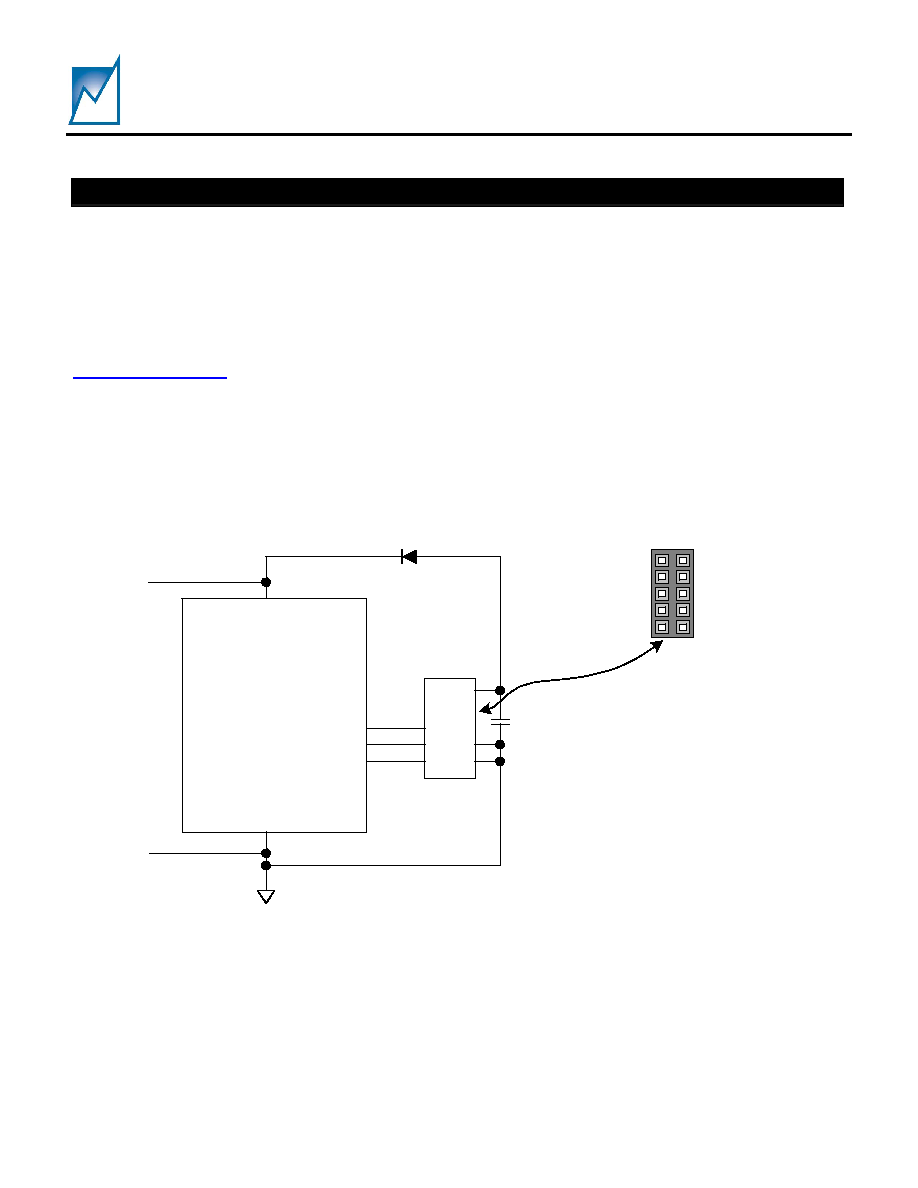
SMM205
Preliminary Information
Summit Microelectronics, Inc
2069 1.4 6/23/03
12
The end user can obtain the Summit SMX3200
programming system for device prototype
development. The SMX3200 system consists of a
programming Dongle, cable and Windows
TM
GUI
software. It can be ordered on the website or from a
local representative. The latest revisions of all
software and an application brief describing the
SMX3200 is available from the website
(
www.summitmicro.com
).
The SMX3200 programming Dongle/cable interfaces
directly between a PC's parallel port and the target
application. The device is then configured on-screen
via an intuitive graphical user interface employing
drop-down menus.
The Windows GUI software will generate the data and
send it in I
2
C serial bus format so that it can be directly
downloaded to the SMM205 via the programming
Dongle and cable. An example of the connection
interface is shown in Figure 8.
When design prototyping is complete, the software
can generate a HEX data file that should be
transmitted to Summit for approval. Summit will then
assign a unique customer ID to the HEX code and
program production devices before the final electrical
test operations. This will ensure proper device
operation in the end application.
Pin 9, 5V
Pin 7, 10V
Pin 5, Reserved
Pin 3, GND
Pin 1, GND
Pin 6, MR#
Pin 4, SDA
Pin 2, SCL
Pin 8, Reserved
Pin 10, Reserved
Top view of straight 0.1" x 0.1 closed-side
connector. SMX3200 interface cable connector.
9
7
5
3
1
10
8
6
4
2
SMM205
SDA
SCL
VDD_CAP
GND
0.1
F
Positive
Supply
Common
Ground
WP#
D1
C1
1N4148
Figure 8≠ SMX3200 Programmer I
2
C serial bus connections to program the SMM205. The SMM205 has a
Write Protect pin (WP#) which, when asserted, prevents writing to the configuration registers and EE
memory. In addition, there is a configuration register lock bit which, once programmed, does not allow the
configuration registers to be changed.
DEVELOPMENT HARDWARE & SOFTWARE

SMM205
Preliminary Information
Summit Microelectronics, Inc
2069 1.4 6/23/03
13
SERIAL INTERFACE
Access to the configuration registers, general-purpose
memory and command and status registers is carried
out over an industry standard 2-wire serial interface
(I
2
C). SDA is a bi-directional data line and SCL is a
clock input. Data is clocked in on the rising edge of
SCL and clocked out on the falling edge of SCL. All
data transfers begin with the MSB. During data
transfers SDA must remain stable while SCL is high.
Data is transferred in 8-bit packets with an intervening
clock period in which an Acknowledge is provided by
the device receiving data. The SCL high period (t
HIGH
)
is used for generating Start and Stop conditions that
precede and end most transactions on the serial bus.
A high-to-low transition of SDA while SCL is high is
considered a Start condition, while a low-to-high
transition of SDA while SCL is high is considered a
Stop condition.
The interface protocol allows operation of multiple
devices and types of devices on a single bus through
unique device addressing. The address byte is
comprised of a 4-bit device type identifier (slave
address) and a 3-bit bus address. The remaining bit
indicates either a read or a write operation. Refer to
Table 1 for a description of the address bytes used by
the SMM205.
The device type identifier for the memory array, the
configuration registers and the command and status
registers are accessible with the same slave address.
It can be programmed to any four bit number 0000
BIN
through 1111
BIN
.
The bus address bits, A2, A1 and A0, are hard wired
though pins 2, 4 and 6 (A2, A1 and A0). The bus
address accessed in the address byte of the serial
data stream must match the setting on the SMM205
address pins.
WRITE
Writing to the memory or a configuration register is
illustrated in Figures 9, 10, 11, 13, 14 and 16. A Start
condition followed by the address byte is provided by
the host; the SMM205 responds with an Acknowledge;
the host then responds by sending the memory
address pointer or configuration register address
pointer; the SMM205 responds with an acknowledge;
the host then clocks in one byte of data. For memory
and configuration register writes, up to 15 additional
bytes of data can be clocked in by the host to write to
consecutive addresses within the same page. After
the last byte is clocked in and the host receives an
Acknowledge, a Stop condition must be issued to
initiate the nonvolatile write operation.
READ
The address pointer for the configuration registers,
memory, command and status registers and ADC
registers must be set before data can be read from the
SMM205. This is accomplished by issuing a dummy
write command, which is simply a write command that
is not followed by a Stop condition. The dummy write
command sets the address from which data is read.
After the dummy write command is issued, a Start
command followed by the address byte is sent from
the host. The host then waits for an Acknowledge and
then begins clocking data out of the slave device. The
first byte read is data from the address pointer set
during the dummy write command. Additional bytes
can be clocked out of consecutive addresses with the
host providing an Acknowledge after each byte. After
the data is read from the desired registers, the read
operation is terminated by the host holding SDA high
during the Acknowledge clock cycle and then issuing a
Stop condition. Refer to Figures 12, 15 and 17 for an
illustration of the read sequence.
WRITE PROTECTION
The SMM205 powers up into a write protected mode.
Writing a code to the volatile write protection register
(write only) can disable the write protection. The write
protection register is located at address 42
HEX
. Writing
to the write protection register is shown in Figure 9.
Writing 0101
BIN
to bits [7:4] of the write protection
register allows writes to the general-purpose memory
while writing 0101
BIN
to bits [3:0] allows writes to the
configuration registers. The write protection can be re-
enabled by writing other codes (not 0101
BIN
) to the
write protection register.
I
2
C PROGRAMMING INFORMATION

SMM205
Preliminary Information
Summit Microelectronics, Inc
2069 1.4 6/23/03
14
CONFIGURATION REGISTERS
The majority of the configuration registers are grouped
with the general-purpose memory. Writing and reading
the configuration registers is shown in Figures 10, 11
and 12.
Note: Configuration writes or reads of registers 00
HEX
to 03
HEX
should not be performed while the SMM205
is margining.
GENERAL-PURPOSE MEMORY
The 1k-bit general-purpose memory is located at any
slave address. The bus address bits are hard wired
by the address pins A2, A1 and A0. Memory writes
and reads are shown in Figures 13, 14 and 15.
COMMAND AND STATUS REGISTERS
Writes and reads of the command and status registers
are shown in Figures 16 and 17.
GRAPHICAL USER INTERFACE (GUI)
Device configuration utilizing the Windows based
SMM205 graphical user interface (GUI) is highly
recommended. The software is available from the
Summit website (
www.summitmicro.com
). Using the
GUI in conjunction with this datasheet and Application
Note 38 simplifies the process of device prototyping
and the interaction of the various functional blocks. A
programming Dongle (SMX3200) is available from
Summit to communicate with the SMM205. The
Dongle connects directly to the parallel port of a PC
and programs the device through a cable using the I
2
C
bus protocol. See figure 8 and the SMX3200 Data
Sheet.
Slave Address Bus Address Register Type
Configuration Registers are located in
00
HEX
thru 45
HEX
ANY
A2 A1 A0
General-Purpose Memory is located in
80
HEX
thru FF
HEX
Table 1 - Address bytes used by the SMM205.
I
2
C PROGRAMMING INFORMATION (CONTINUED)
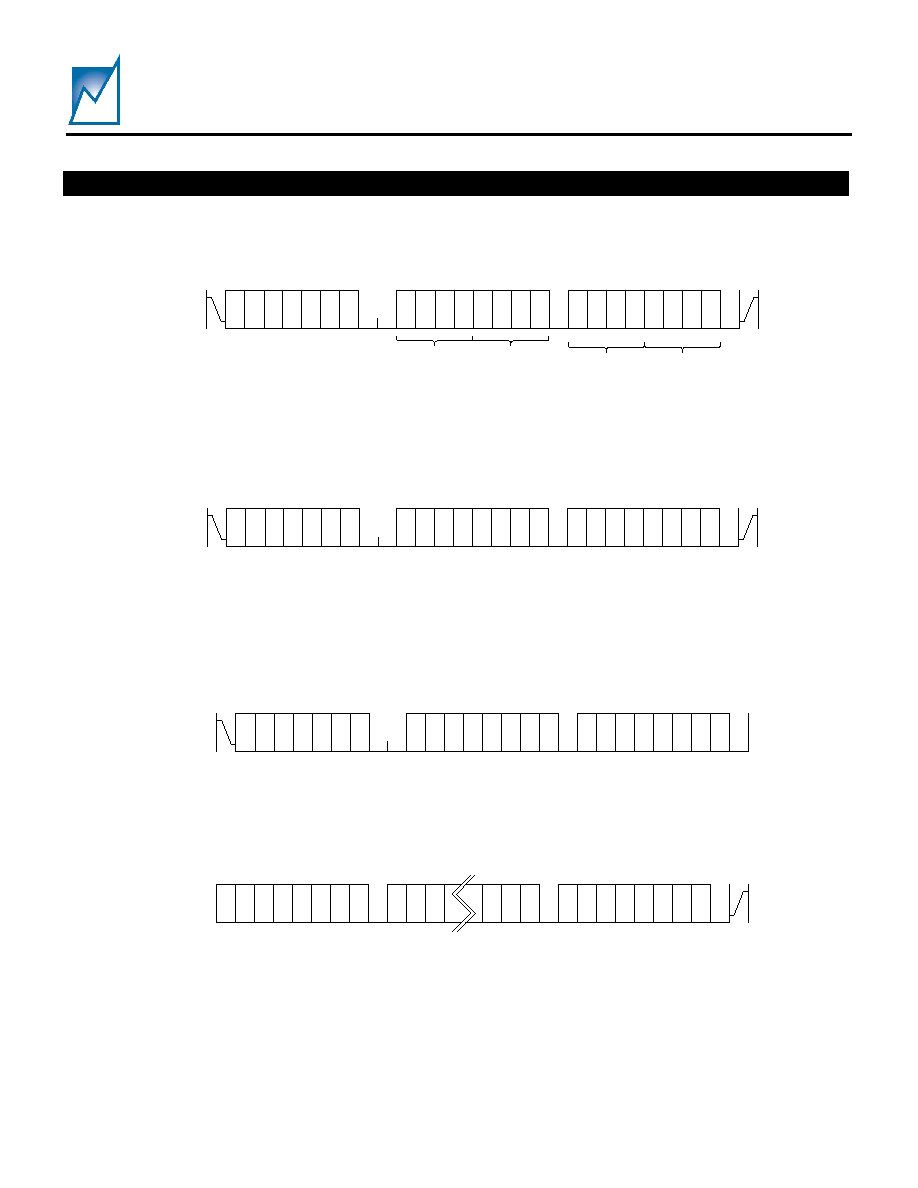
SMM205
Preliminary Information
Summit Microelectronics, Inc
2069 1.4 6/23/03
15
S
T
A
R
T
W
A
C
K
Master
Slave
A
C
K
Configuration
Register Address = 42
HEX
0
1
0
0
0
0
1
0
0
1
0
1
0
1
0
1
S
T
O
P
Data = 55
HEX
A
C
K
A
2
Bus Address
A
1
A
0
5
HEX
Unlocks
General Purpose
EE
5
HEX
Unlocks
Configuration
Registers
Write Protection
Register Address
S
A
3
S
A
2
S
A
1
S
A
0
4
HEX
2
HEX
Figure 9 ≠ Write Protection Register Write
S
T
A
R
T
Bus Address
W
A
C
K
M aster
Slave
A
C
K
Configuration
Register Address
C
7
C
6
C
5
C
4
C
3
C
2
C
1
C
0
D
7
D
6
D
5
D
4
D
3
D
2
D
1
D
0
S
T
O
P
Data
A
C
K
A
2
A
1
A
0
S
A
3
S
A
2
S
A
1
S
A
0
Figure 10 ≠ Configuration Register Byte Write
S
T
A
R
T
Bus Address
W
A
C
K
D
7
D
6
D
5
D
4
D
3
D
2
D
1
D
0
S
T
O
P
M aster
M aster
Slave
Slave
A
C
K
Data (16)
Configuration
Register Address
C
7
C
6
C
5
C
4
C
3
C
2
C
1
C
0
A
C
K
D
7
D
6
D
5
D
4
D
3
D
2
D
1
D
0
Data (1)
A
C
K
D
7
D
6
D
5
D
4
D
3
D
2
D
1
D
0
Data (2)
A
C
K
D
7
D
6
D
5
D
2
D
1
D
0
A
C
K
A
2
A
1
A
0
S
A
3
S
A
2
S
A
1
S
A
0
Figure 11 ≠ Configuration Register Page Write
I
2
C PROGRAMMING INFORMATION (CONTINUED)

SMM205
Preliminary Information
Summit Microelectronics, Inc
2069 1.4 6/23/03
16
S
T
A
R
T
Bus Address
W
A
C
K
D
7
D
6
D
5
D
4
D
3
D
2
D
1
D
0
S
T
O
P
N
A
C
K
M aster
M aster
Slave
Slave
A
C
K
Data (n)
Configuration
Register Address
C
7
C
6
C
5
C
4
C
3
C
2
C
1
C
0
S
T
A
R
T
R
A
C
K
Bus Address
A
C
K
D
7
D
6
D
5
D
2
D
1
D
0
A
C
K
D
7
D
6
D
5
D
4
D
3
D
2
D
1
D
0
Data (1)
A
2
A
1
A
0
S
A
3
S
A
2
S
A
1
S
A
0
A
2
A
1
A
0
S
A
3
S
A
2
S
A
1
S
A
0
Figure 12 - Configuration Register Read
S
T
A
R
T
Bus Address
W
A
C
K
M aster
Slave
A
C
K
Configuration
Register Address
C
7
C
6
C
5
C
4
C
3
C
2
C
1
C
0
D
7
D
6
D
5
D
4
D
3
D
2
D
1
D
0
S
T
O
P
Data
A
C
K
A
2
A
1
A
0
S
A
3
S
A
2
S
A
1
S
A
0
Figure 13 ≠ General Purpose Memory Byte Write
Bus Address
S
T
A
R
T
W
A
C
K
D
7
D
6
D
5
D
4
D
3
D
2
D
1
D
0
S
T
O
P
M aster
M aster
Slave
Slave
A
C
K
Data (16)
Configuration
Register Address
C
7
C
6
C
5
C
4
C
3
C
2
C
1
C
0
A
C
K
D
7
D
6
D
5
D
4
D
3
D
2
D
1
D
0
Data (1)
A
C
K
D
7
D
6
D
5
D
4
D
3
D
2
D
1
D
0
Data (2)
A
C
K
D
7
D
6
D
5
D
2
D
1
D
0
A
C
K
A
2
A
1
A
0
S
A
3
S
A
2
S
A
1
S
A
0
Figure 14 - General Purpose Memory Page Write
I
2
C PROGRAMMING INFORMATION (CONTINUED)

SMM205
Preliminary Information
Summit Microelectronics, Inc
2069 1.4 6/23/03
17
S
T
A
R
T
W
A
C
K
D
7
D
6
D
5
D
4
D
3
D
2
D
1
D
0
S
T
O
P
N
A
C
K
M aster
M aster
Slave
Slave
A
C
K
Data (n)
Configuration
Register Address
C
7
C
6
C
5
C
4
C
3
C
2
C
1
C
0
S
T
A
R
T
R
A
C
K
A
C
K
D
7
D
6
D
5
D
2
D
1
D
0
A
C
K
D
7
D
6
D
5
D
4
D
3
D
2
D
1
D
0
Data (1)
Bus Address
Bus Address
A
2
A
1
A
0
S
A
3
S
A
2
S
A
1
S
A
0
A
2
A
1
A
0
S
A
3
S
A
2
S
A
1
S
A
0
Figure 15 - General Purpose Memory Read
S
T
A
R
T
W
A
C
K
M aster
Slave
A
C
K
Command and Status
Register Address
C
7
C
6
C
5
C
4
C
3
C
2
C
1
C
0
D
7
D
6
D
5
D
4
D
3
D
2
D
1
D
0
S
T
O
P
Data
A
C
K
Bus Address
A
2
A
1
A
0
S
A
3
S
A
2
S
A
1
S
A
0
Figure 16 ≠ Command and Status Register Write
S
T
A
R
T
W
A
C
K
D
7
D
6
D
5
D
4
D
3
D
2
D
1
D
0
S
T
O
P
N
A
C
K
M aster
M aster
Slave
Slave
A
C
K
Data (n)
Command and Status
Register Address
C
7
C
6
C
5
C
4
C
3
C
2
C
1
C
0
S
T
A
R
T
R
A
C
K
A
C
K
D
7
D
6
D
5
D
2
D
1
D
0
A
C
K
D
7
D
6
D
5
D
4
D
3
D
2
D
1
D
0
Data (1)
Bus Address
Bus Address
A
2
A
1
A
0
S
A
3
S
A
2
S
A
1
S
A
0
A
2
A
1
A
0
S
A
3
S
A
2
S
A
1
S
A
0
Figure 17 - Command and Status Register Read
I
2
C PROGRAMMING INFORMATION (CONTINUED)

SMM205
Preliminary Information
Summit Microelectronics, Inc
2069 1.4 6/23/03
18
DEFAULT CONFIGURATION REGISTER SETTINGS ≠ SMM205F-167
Register Contents
Function
R00
01
Channel A Nominal Voltage is set to 2.503V (MSB)
R01
FF
Channel A Nominal Voltage is set to 2.503V (MSB)
R02
02
Channel B Nominal Voltage is set to 1.801V (MSB)
R03
C6
Channel B Nominal Voltage is set to 1.801V (MSB)
R04 AF
Channel A and B ADOC is enabled, Trim polarity is inverse, Fast Convergence,
VREF External, Fault Latched by a Fault Condition
R05
05
Slave address is 0101
R06 28
No Write Command Required to Activate ADOC, Internal Regulator set to 3.6V,
Fault Output Enabled While Margining, Configuration Registers Unlocked, COMP1
and COMP2 are set to sense UV
R08
00
Margin Command Bits
R0C
12
Stores VREF_CNTL value set to 1.25
R0D
50
Stores VREF_CNTL value set to 1.25
R20
01
Channel A - Margin High Voltage is set to 2.805V (MSB)
R21
C8
Channel A - Margin High Voltage is set to 2.805V (LSB)
R22
02
Channel B - Margin High Voltage is set to 2.100V (MSB)
R23
61
Channel B - Margin High Voltage is set to 2.100V (LSB)
R30
02
Channel A - Margin Low Voltage is set to 2.201V (MSB)
R31
45
Channel A - Margin Low Voltage is set to 2.201V (LSB)
R32
03
Channel B - Margin Low Voltage is set to 1.501V (MSB)
R33
54
Channel B - Margin Low Voltage is set to 1.501V (LSB)
R40
00
Margin Command Status Bits
R41
03
READY and START pin Polarities set to Active High
R42 FF
Write
Protect
R44
00
Fault Status Bits
RC1
The default device ordering number -- SMM205F-167 -- is programmed as described
above and tested over the commercial temperature range. Application Note 41 contains a
complete description of the Windows GUI and the default settings of each of the 22
individual Configuration Registers.
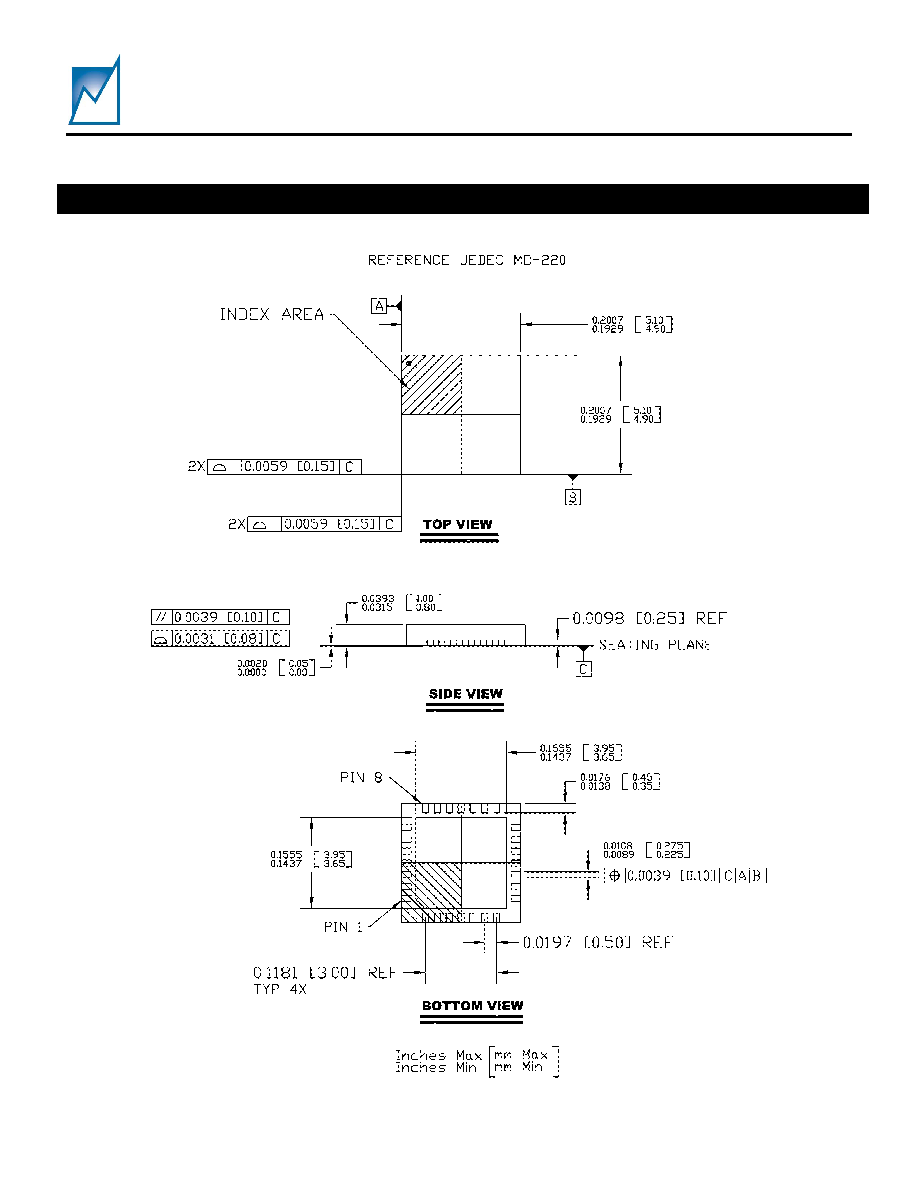
SMM205
Preliminary Information
Summit Microelectronics, Inc
2069 1.4 6/23/03
19
28 Pin QFN
PACKAGE
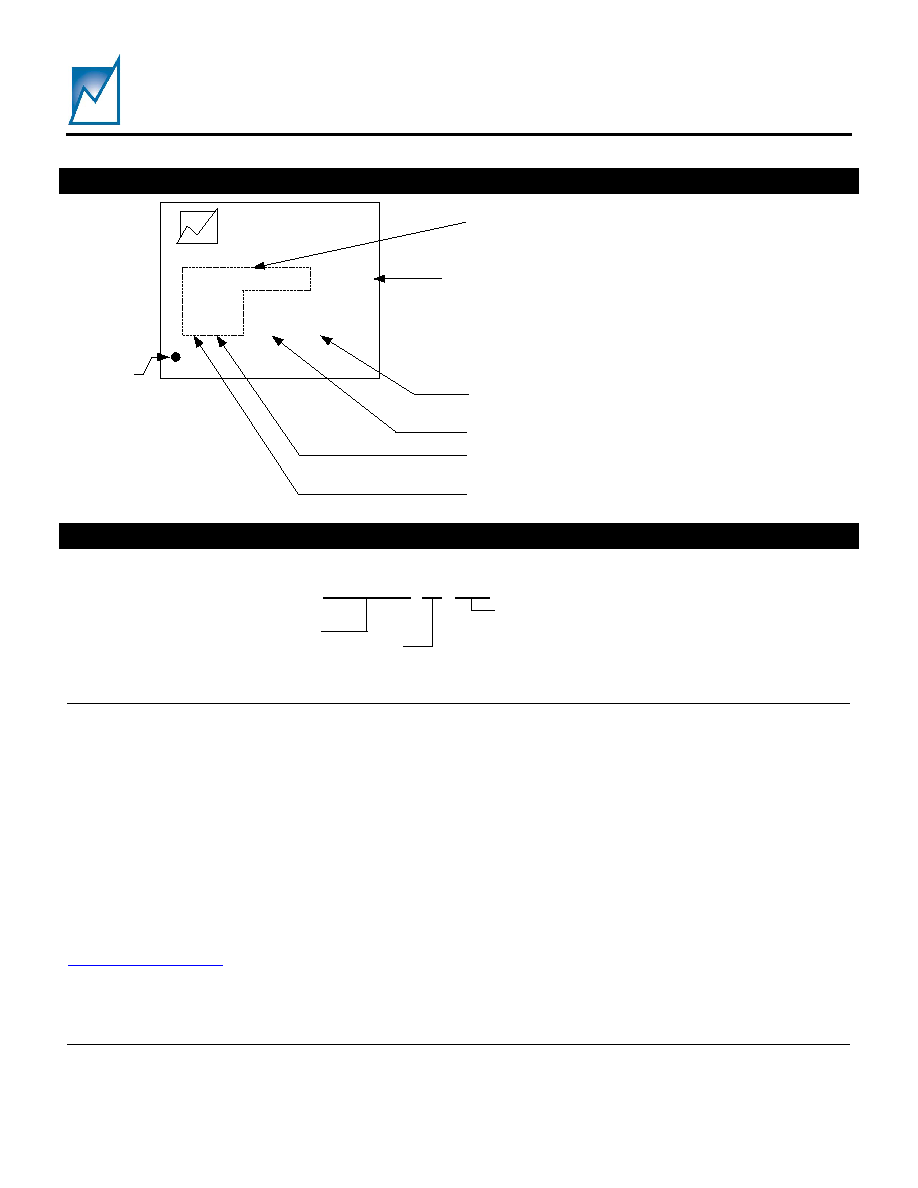
SMM205
Preliminary Information
Summit Microelectronics, Inc
2069 1.4 6/23/03
20
PART MARKING
SUMMIT
SMM205N
AYYW W
Pin 1
Annn
Summit Part Number
Date Code (YYW W )
Part Number suffix
(Contains Customer specific ordering requirements)
Lot tracking code (Sum m it use)
Drawing not to scale
xx
Status Tracking Code
(Blank, MS, ES, 01, 02,...)
(Sum m it Use)
Product T racking Code (Summit use)
ORDERING INFORMATION
NOTICE
NOTE 1 -
This is a Preliminary Information data sheet that describes a Summit product currently in pre-production with limited characterization.
SUMMIT Microelectronics, Inc. reserves the right to make changes to the products contained in this publication in order to improve design,
performance or reliability. SUMMIT Microelectronics, Inc. assumes no responsibility for the use of any circuits described herein, conveys no
license under any patent or other right, and makes no representation that the circuits are free of patent infringement. Charts and schedules
contained herein reflect representative operating parameters, and may vary depending upon a user's specific application. While the information in
this publication has been carefully checked SUMMIT Microelectronics, Inc. shall not be liable for any damages arising as a result of any error or
omission.
SUMMIT Microelectronics, Inc. does not recommend the use of any of its products in life support or aviation applications where the failure or
malfunction of the product can reasonably be expected to cause any failure of either system or to significantly affect their safety or effectiveness.
Products are not authorized for use in such applications unless SUMMIT Microelectronics, Inc. receives written assurances, to its satisfaction, that:
(a) the risk of injury or damage has been minimized; (b) the user assumes all such risks; and (c) potential liability of SUMMIT Microelectronics, Inc.
is adequately protected under the circumstances.
Revision 1.4 -- This document supersedes all previous versions. Please check the Summit Microelectronics, Inc. web site for data sheet updates
www.summitmicro.com
.
© Copyright 2003 SUMMIT MICROELECTRONICS, Inc.
Power Management for CommunicationsTM
I2C is a trademark of Philips Corporation.
SMM205
N nnn
Package
N=28 Lead QFN
Part Number Suffix (see page 18)
Summit Part Number
Specific requirements are contained in the suffix
such as Commercial or Industrial Temp Range,
Hex code, Hex code revision, etc.



















